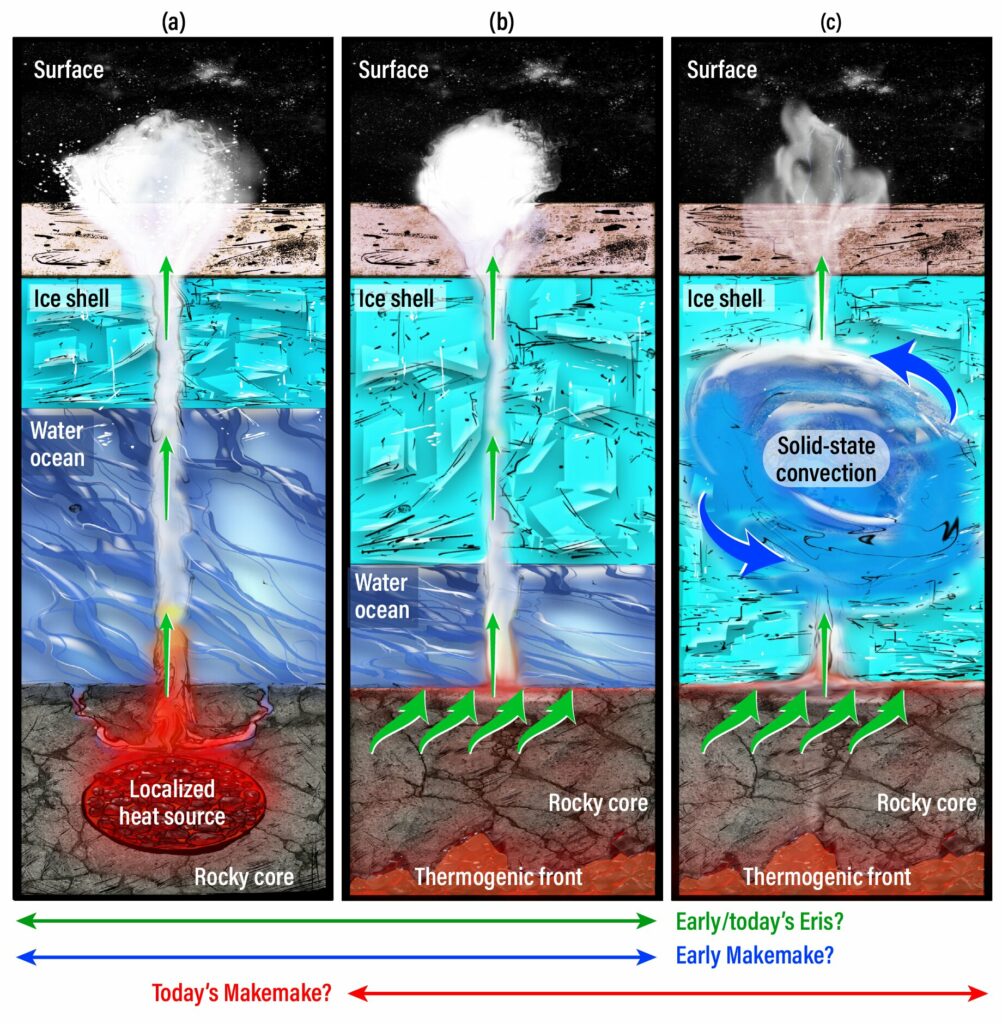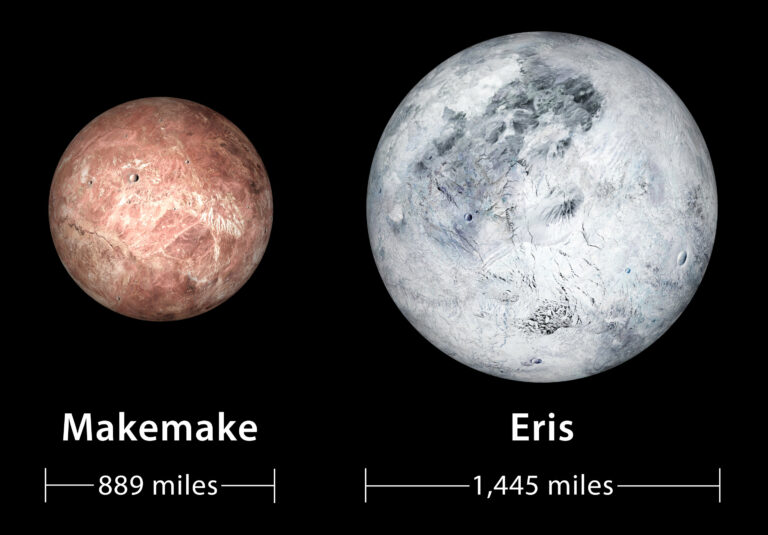Researchers discover signs of geothermal activity within frigid dwarf planets
Dr. Christopher Glein, an expert in planetary geochemistry and lead author of a paper on the subject, stated, “We have observed intriguing indications of high temperatures in otherwise cold environments.” Initially, it was anticipated that large Kuiper Belt objects (KBOs) such as Eris and Makemake would possess ancient surfaces composed of materials inherited from the early solar nebula. This assumption was based on the understanding that their frigid exteriors could preserve volatile substances like methane. However, the James Webb Space Telescope (JWST) provided an unexpected revelation. It presented evidence suggesting that thermal processes occurring within Eris and Makemake are responsible for the production of methane.
Situated at the outer reaches of the solar system, beyond Neptune’s orbit, the Kuiper Belt is an expansive region resembling a donut, consisting of icy celestial bodies. Eris and Makemake, similar in size to Pluto and its moon Charon, likely formed during the early stages of our solar system’s development approximately 4.5 billion years ago. Previously believed to be lifeless and cold, KBOs were presumed to lack any significant heat due to their considerable distance from the sun.
Newly released research conducted by the JWST team has provided groundbreaking insights into the presence of isotopic molecules on the surfaces of Eris and Makemake. These unique molecules, known as isotopologues, consist of atoms with varying numbers of neutrons. The data obtained from these observations are invaluable in enhancing our understanding of planetary evolution.
The team utilized the JWST to analyze the composition of the dwarf planets’ surfaces, with a specific focus on the ratio of deuterium (heavy hydrogen, D) to hydrogen (H) in methane. Deuterium is believed to have originated from the Big Bang and hydrogen is the most abundant nucleus in the universe. By examining the D/H ratio on these planetary bodies, we can gain insights into the origin, geological history, and formation processes of hydrogen-containing compounds.

Dr. Glein, a member of the research team, stated, “The D/H ratio we observed with JWST indicates the presence of ancient methane on the surface, despite the moderate ratio. If the methane were primordial, the D/H ratio would be significantly higher.”
Instead, the D/H ratio suggests that the methane has geochemical origins, originating from the deep interior of these dwarf planets. The D/H ratio acts as a window, allowing us to glimpse into the subsurface. Our findings indicate elevated temperatures in the rocky cores of these worlds, enabling the production of methane. Additionally, we have observed the presence of molecular nitrogen (N2) on Eris. The existence of hot cores also suggests the potential presence of liquid water beneath the icy surfaces.
In the past two decades, scientists have discovered that icy worlds can be far more internally complex than previously thought. Subsurface oceans have been detected on various icy moons, including Enceladus (Saturn’s moon) and Europa (Jupiter’s moon). The presence of liquid water is a crucial factor in determining the potential habitability of a planet.
Scientists are planning to investigate the potential existence of water oceans within Eris and Makemake in the coming years. If either of these celestial bodies is found to be habitable, it would become the most distant world in the solar system capable of supporting life. The discovery of chemical indicators of internal processes brings them closer to this goal.
Dr. Will Grundy, an astronomer at Lowell Observatory and lead author of a related paper, stated, “If Eris and Makemake have warm or even hot geochemistry in their rocky cores, cryovolcanic processes could transport methane to their surfaces, possibly in recent geological times.”
The identification of a carbon isotope ratio (13C/12C) suggests that resurfacing has occurred relatively recently.
This research represents a shift in the field of planetary science, as it is increasingly recognized that cold, icy worlds may have warm interiors. The study’s models also indicate the presence of geothermal gases on Saturn’s moon Titan, which shares an abundance of methane. Additionally, the discovery of unexpected activity on Eris and Makemake highlights the significance of internal processes in shaping the features observed on large Kuiper Belt Objects, aligning with previous findings on Pluto.
Glein remarked, “Following the New Horizons mission’s exploration of the Pluto system and this new discovery, it is becoming evident that the Kuiper Belt is home to dynamic worlds beyond our expectations. It is not too early to consider sending a spacecraft to explore another one of these bodies and provide a geological context for the data collected by the James Webb Space Telescope. I am confident that we will be amazed by the marvels that await us.”
This article is republished from PhysORG under a Creative Commons license. Read the original article.
Do not forget to share your opinion with us to provide you with the best posts !




0 Comments